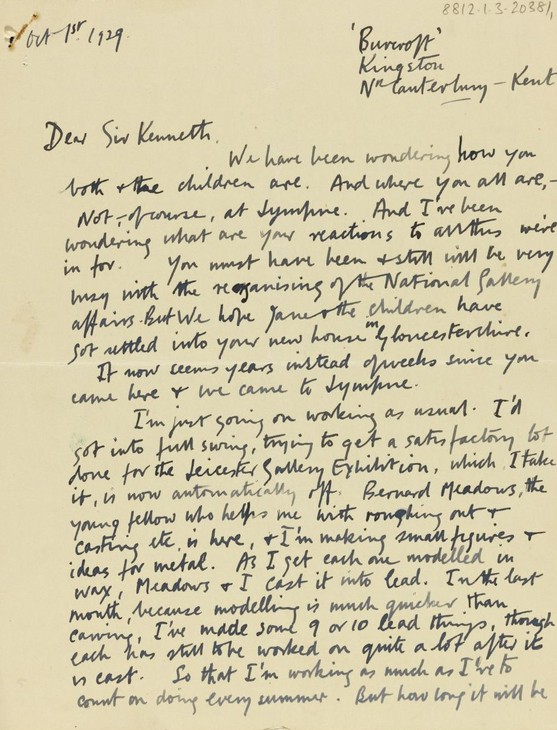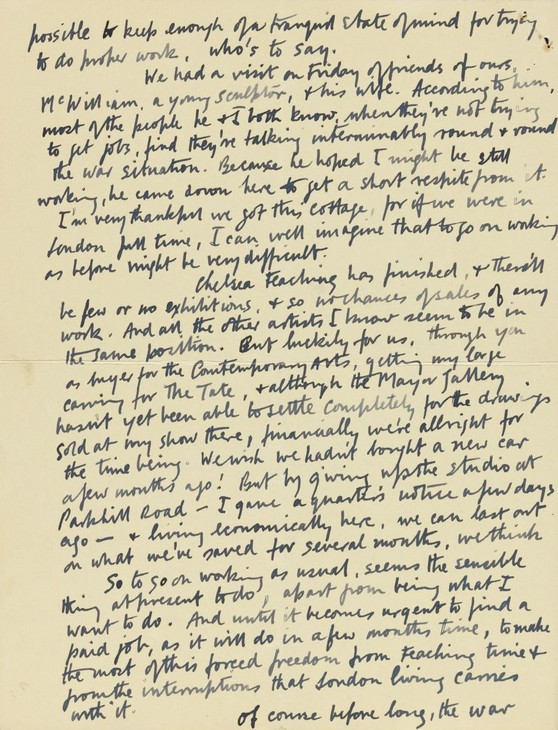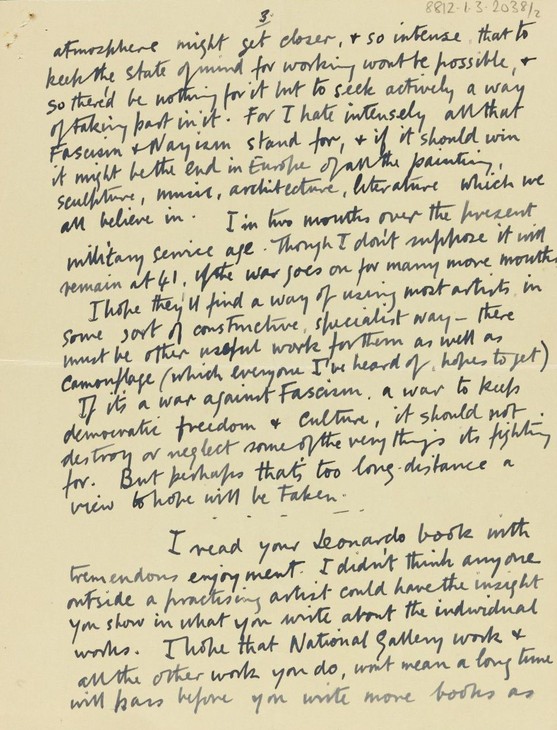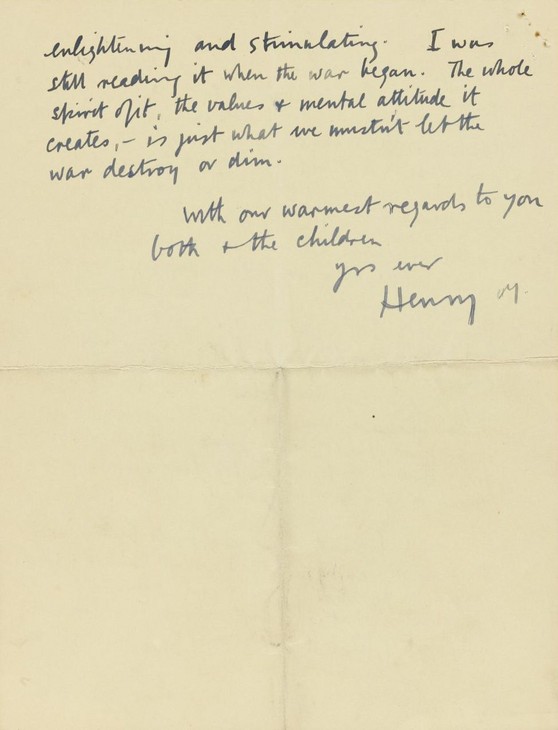Henry Moore Letter to Sir Kenneth Clark 1 October 1939
In this thoughtful letter to Clark Moore wrote about his personal position and outlook at the outbreak of the Second World War. His plans for an exhibition had been cancelled, and he had no hope of further teaching at Chelsea because of the war. Luckily, he had enough money put by to allow him to concentrate on making art for a few months (he talked here about making a series of small lead sculptures, working with the assistance of a student at the Royal College of Art, Bernard Meadows, as modelling was quicker than carving). But he knew that he would soon need a job, like so many artists, to make ends meet and to engage with the war effort.
At forty-one, he was too old for conscription but recognised here that before long ‘to keep the state of mind for working won’t be possible, and so there’d be nothing for it but to seek actively a way of taking part in it’. As art and culture were essential components of what Britain was fighting for, he wanted artists to be used ‘in some sort of constructive, specialist way’. His words may have chimed with, or spurred on, ideas already in Clark’s mind. In November 1939 the War Artists’ Advisory Committee was established, with the purpose of employing artists to create images of all aspects of the war, with Clark as its Chairman.
Transcript
[Handwritten:]
Oct 1st 1929 [sic: 1939]
‘Burcroft’
Kingston
Nr Canterbury – Kent
Kingston
Nr Canterbury – Kent
Dear Sir Kenneth,
We have been wondering how you both and the children are. And where you all are, – Not, of course, at Lympne. And I’ve been wondering what are your reactions to all this we’re in for. You must have been and still will be very busy with the reorganising of the National Gallery affairs. But we hope Jane and the children have got settled into your new house in Gloucestershire. It now seems years instead of weeks since you came here and we came to Lympne.
I’m just going on working as usual. I’d got into full swing, trying to get a satisfactory lot done for the Leicester Gallery Exhibition, which I take it, is now automatically off. Bernard Meadows, the young fellow who helps me with roughing out and casting etc, is here, and I’m making small figures and ideas for metal. As I get each one modelled in wax, Meadows and I cast it into lead. In the last month, because modelling is much quicker than carving, I’ve made some 9 or 10 lead things, though each has still to be worked on quite a lot after it is cast. So that I’m working as much as I’ve to count on doing every summer. But how long it will be [end of p.1] possible to keep enough of a tranquil state of mind for trying to do further work, who’s to say.
We had a visit on Friday of friends of ours, McWilliam, a young sculptor, and his wife. According to him, most of the people he and I both know, when they’re not trying to get jobs, find they’re talking interminably round and round the war situation. Because he hoped I might be still working, he came down here to get a short respite from it. I I’m very thankful we got this cottage, for if we were in London full time, I can well imagine that to go on working as before might be very difficult.
Chelsea Teaching has finished, and there’ll be few or no exhibitions, and so no chances of sales of any work. And all the other artists I know seem to be in the same position. But luckily for us, through you as buyer for the Contemporary Arts, getting my large carving for the Tate, and although the Mayor Gallery hasn’t yet been able to settle completely for the drawings sold at my show there, financially we’re alright the time being. We wish we hadn’t bought a new car a few months ago! But by giving up the studio at Parkhill Road – I gave a quarter’s notice a few days ago – and living economically here, we can last out on what we’ve saved for several months, we think.
So to go on working as usual, seems the sensible thing at present to do, apart from being what I want to do. And until it becomes urgent to find a paid job, as it will do in a few months time, to make the most of this forced freedom from teaching time and from the interruptions that London living carries with it.
Of course before long, the war [end of p.2] atmosphere might get closer, and so intense, that to keep the state of mind for working won’t be possible, and so there’d be nothing for it but to seek actively a way of taking part in it. For I hate intensely all that Fascism and Nazism stand for, and if it should win it might be the end in Europe of all the painting, sculpture, music, architecture, literature which we all believe in.
I’m two months over the present military service age. Though I don’t suppose it will remain at 41, if the war goes on for many more months.
I hope they’ll find a way of using most artists in some sort of constructive, specialist way – there must be other useful work for them as well as camouflage (which everyone I’ve heard of hopes to get). If it’s a war against Fascism, a war to keep democratic freedom and culture, it should not destroy or neglect some of the very things it’s fighting for. But perhaps that’s too long-distance a view to hope will be taken.
- - - - -
I read your Leonardo book with tremendous enjoyment. I didn’t think anyone outside a practising artist could have the insight you show in what you write about the individual works. I hope that National Gallery work and all the other work you do, won’t mean a long time will pass before you write more books as [end of p.3] enlightening and stimulating. I was still reading it when the war began. The whole spirit of it, the values and mental attitude it creates, – is just what we mustn’t let the war destroy or dim.
With our warmest regards to you both and the children
Yours ever
Henry M.
How to cite
Henry Moore, Letter to Sir Kenneth Clark, 1 October 1939, in Henry Moore: Sculptural Process and Public Identity, Tate Research Publication, 2015, https://www




